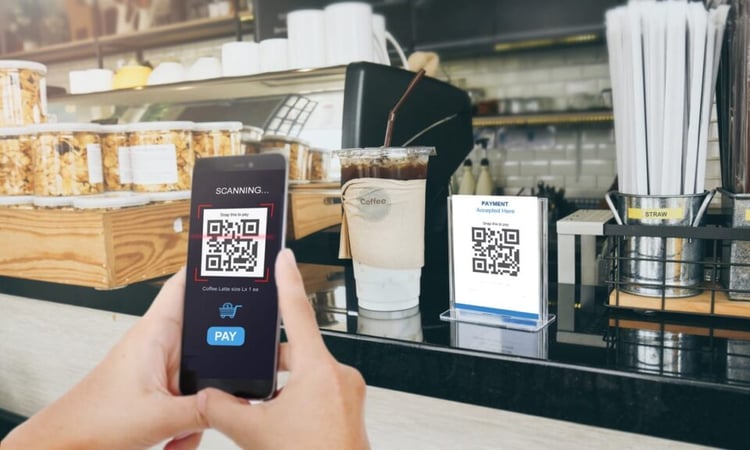What are QR payments?

QR payments, or Quick Response payments, make accepting payments faster and easier in the world of digital transactions. As more and more consumers embrace the convenience of cashless purchases, banks, and financial institutions must adapt to this shift since businesses are increasingly accepting QR code payments.
By using payment apps and scanning a QR code with their smartphone, customers can swiftly complete transactions without the need for physical cards or cash. For banks and financial institutions, the adoption of QR payment systems can provide numerous benefits, including increased transaction speed, enhanced security, and improved customer convenience.
What are QR codes?
QR codes are two-dimensional barcodes that can be read using smartphones or dedicated QR-reading devices. They were first designed in 1994 for the automotive industry in Japan. A QR code instantly delivers what is encoded within it as soon as it is scanned.
In the context of payments, a QR code contains the information required to complete a transaction such as the recipient's account details and the payment amount. By simply scanning the QR code with a smartphone, this information is instantly transferred, enabling a quick and seamless payment process. Convenience and efficiency are what make QR payments a popular choice in today's digital age.

How do QR codes work?
QR codes work on the principle of optical data storage. Unlike a one-dimensional barcode that stores data horizontally, a QR code does so in a two-dimensional grid, allowing for a significantly higher amount of information to be encoded. This data is typically comprised of tiny square modules arranged within a larger square pattern.
When a QR code is scanned by a smartphone or a dedicated QR code reader, the device interprets the contrasts between the dark and light areas of the code. The three large squares at the corners of the QR code guide the reader to recognize and appropriately orientate the QR code. The smaller squares or pixels within the QR pattern represent binary data, which is then decoded into the information they hold.
In the case of QR payments, this information is typically a URL or other data directly linking to a payment page on an online payment platform, complete with the transaction details.
What are QR code payments?
QR code payments are a type of contactless payment method where transactions are done through the scanning of a QR code from a mobile payment app. The way it works is relatively simple. A customer uses their smartphone camera to scan QR codes displayed by the merchant. This QR code contains the necessary transaction details.
Once scanned, the customer confirms the payment amount on their mobile device, and the transaction is processed digitally over a secure network, instantly debiting the customer's preferred digital wallet or bank account. The merchant receives immediate confirmation of the transaction, making the process seamless and efficient.
How do QR code payments work?
Customers make payments by scanning this code using a mobile banking app or digital wallet that supports QR code transactions. Upon scanning the code, the information is rapidly processed, and the payment can be completed with just a tap on the user's screen.
After scanning, the app automatically fills in the payment details. The customer then needs to confirm the transaction, after which the amount is directly debited from their account and credited to the merchant's account.
Benefits of letting customers pay with QR codes
Take faster payments & serve more customers
This form of payment is becoming increasingly popular due to its convenience and speed, offering a ‘touch-and-go’ method which can be particularly beneficial in the era of social distancing.
Once a QR code is scanned, the payment details are immediately processed, and after confirming the transaction, the payment is completed. This process takes a matter of seconds, drastically reducing the time spent on transactions.
This increased speed of a QR code payment system can enhance customer satisfaction, reduce queues, and improve your financial institution's efficiency.
Simple setup and no expensive hardware
Setting up QR code payments is a simple and straightforward process. Merchants who accept QR payments only need to register with a payment provider that offers QR payment services. After registration, the provider will supply a unique QR code that corresponds to the merchant's account. This code can be printed or displayed digitally at the point of sale.
Different QR codes can be generated for different payment amounts or products, enabling them to streamline the payment process. It requires no expensive hardware, making it a cost-efficient option for both small and large businesses.
QR code payments can also reduce the need for physical point-of-sale systems, potentially saving businesses money on hardware.
Implement better security when you accept payments
QR codes for payments can be designed to be dynamic or single-use, meaning they change after each transaction, reducing the risk of fraud.
Dynamic QR codes change each time they are scanned. For every new transaction, a unique QR code is generated. This provides an extra layer of security, as the code only works for one transaction and cannot be reused by fraudsters. Dynamic QR codes can also be used to track the details of each transaction, as each code has unique information associated with it.
Single-use QR codes, also known as one-time QR codes, become invalid after one use. These codes are typically used for high-value transactions or for transactions where additional security is required.
Similar to dynamic QR codes, single-use QR codes prevent potential fraudsters from reusing the code, as it becomes invalid after it has been scanned once. This feature provides an additional layer of security and can help ensure the safety and integrity of the transaction.
Adapt future-ready technology with Episode 6
At E6, our technology seamlessly integrates with your tech stack. Offer customers new, future-ready services and options for mobile payments without disrupting your existing systems.
Ready to empower customers with seamless payment options, eliminating the need for physical cards? Contact us to see how we can help.

E6 Team
About the Author
Episode Six provides financial institutions with solutions for legacy payment stacks that aren’t fulfilling the needs of an expanding industry. We are a global provider of enterprise-grade payment technology and ledger management infrastructure for banks that need to keep pace with disruptors and evolving consumer preferences.

